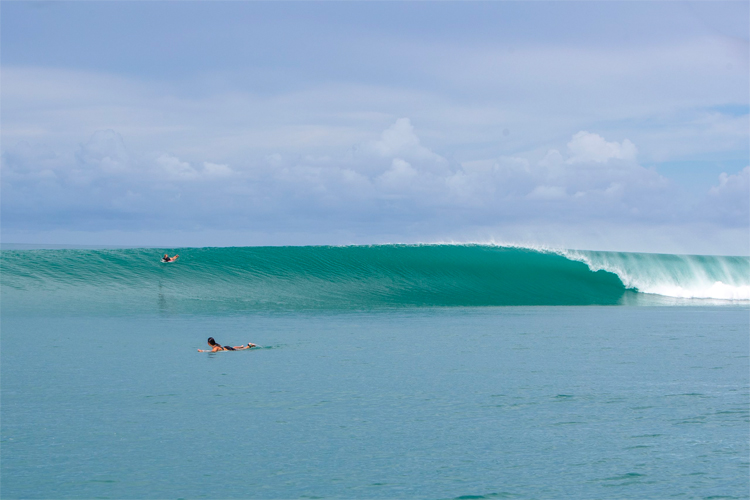Nias, also known as Pulau Nias, is an enchanting island located off the western coast of Sumatra, Indonesia.
It is home to the world-famous surf break, Lagundri Bay, which has attracted surfers from across the globe since its discovery in 1975.
The legendary, jaw-dropping Indo wave breaks in a breathtaking setting, as seen in the surf movies "Asian Paradise" (1981), "Stormriders" (1982), "The Golden Pig" (1996), and "Nias - Point of Change" (2017).
The fabulous surfing spot is also commonly and mistakenly referred to as Nias.
Join us as we explore the wonders of Nias and the unparalleled surfing experience at Lagundri Bay.
Immerse yourself in the island's rich history, unique geography, and ever-evolving surfing conditions, which have been shaped by both natural and man-made forces.
Our comprehensive guide reveals what makes Nias a truly extraordinary and mystical surfing destination that continues to captivate and inspire wave riders from around the world.
Strategically Located
Situated 80 miles (128 kilometers) off the west coast of Sumatra, Pulau Nias is an island in Indonesia fully exposed to the magical Indian Ocean.
Lagundri Bay, in particular, lies on the island's southern end, providing a picturesque setting with coconut palms, emerald green waters, and perfectly shaped waves.
The highly sheltered cove funnels the south swells and shapes them into world-class fast-breaking barrels.
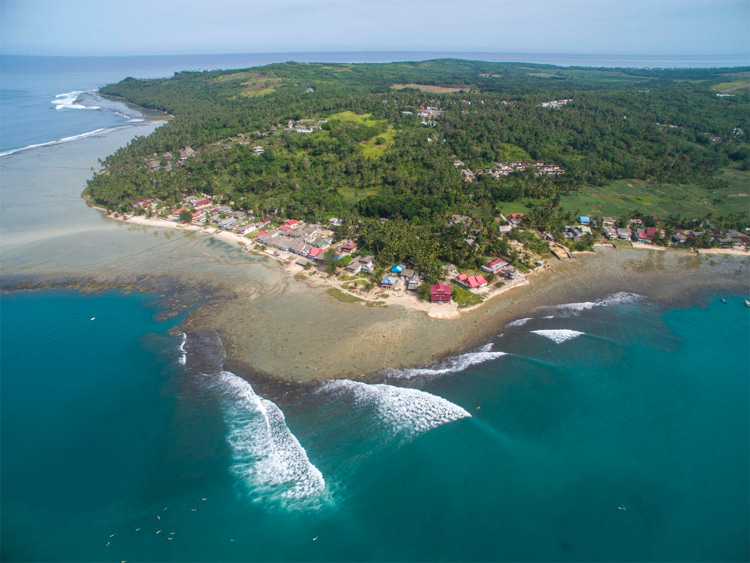
History
The discovery of Lagundri Bay in 1975 is a tale of adventure, camaraderie, and tragedy.
Australian surf travelers Kevin Lovett, Peter Troy, and John Geisel stumbled upon the perfect 6 to 8-foot right reef break and reveled in the surf for several days.
While Lovett returned to Nias within a year, Geisel tragically passed away from pneumonia brought on by malaria contracted on the island.
By 1979, Nias had become an international surf sensation after being featured in Surfer magazine.
Lagundri natives began surfing in the mid-1980s with the help of Australian Mark Flint, who started making boards locally.
The Nias Surf Club was soon founded, and local farmer and landowner Ana Dalin started developing Lagundri Bay for surf tourism in the early 1980s.
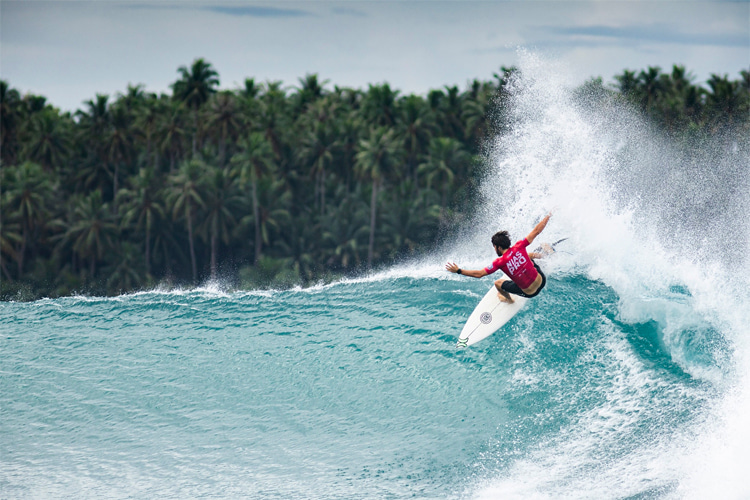
When to Go
The best time for surfing at Lagundri Bay is during the May-to-October dry season.
During this period, the Indian Ocean generates consistent swells, and the winds are generally favorable for surfing.
Lagundri Bay's waves depend on the swells coming from the southern reaches of the Indian Ocean, heading north past the Mentawai Islands.
The waves can range from 3 to 15 feet, with the most significant swells usually occurring in June, July, and August.
The dry season is also the peak tourist season, so expect more crowded lineups, especially during the months of June and July.
The conditions can still be good for surfing during the shoulder months of March and October, although they may be less consistent.
From November to February, the wet season experiences less reliable surf conditions, with onshore winds and smaller swells, but you may still find some fun waves and fewer crowds during this time.
It's worth noting that the climate in Nias is tropical, so air and water temperatures remain warm throughout the year, ranging from 70-80 °F (21-26 °C), allowing for comfortable surfing without the need for a wetsuit.
The tidal range is only 1-3 feet (0.33-1 meter), but it could be enough to expose the sharp, seaweed-covered reef.
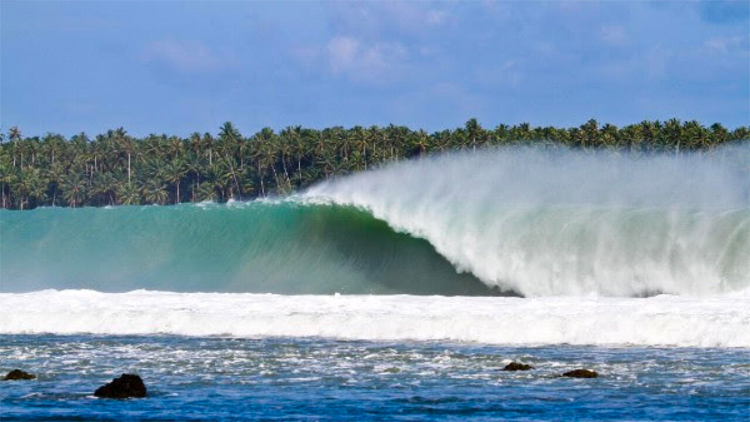
The Wave at Lagundri Bay
Lagundri Bay's right-breaking tube, known as The Point, is formed by a shallow lava platform.
The wave is famous for its smooth, perfectly tapered wall that spills over into an almond-shaped tube.
The drops can be vertical, and the lip is punishing, providing deep-throated, nine-second tube rides for the brave.
The peak is tucked nearly a half-mile (800 meters) inside the U-shaped bay.
Although the waves at Lagundri are typically one-third to one-half smaller than those at Grajagan (Java) or Uluwatu (Bali), the bay still offers an exceptional surfing experience.
The earthquake in 2005, which raised the reefs and made the platform shallower, improved the wave quality at Lagundri Bay, making it even more attractive to surfers.
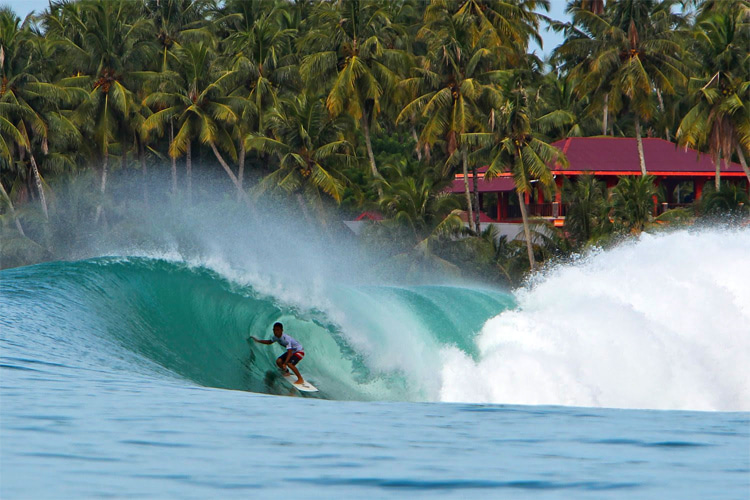
Tsunami and Earthquake
The 2004 Boxing Day tsunami largely spared Lagundri Bay, but the region was significantly affected by a massive earthquake on March 28, 2005.
The earthquake, registering 8.7 on the Richter Scale, caused the deaths of over 600 people and injured more than 2000 on Nias Island.
Buildings across the island were destroyed, including houses around the Sorake Beach area of Lagundri Bay.
Surprisingly, the earthquake also altered the surf conditions in the bay, raising the reef by a couple of feet and enhancing the quality of the waves.
In the aftermath, surfers from around the world provided aid and support for both short-term and long-term restructuring of the area.
Within weeks, surfers returned to the rebuilt losmen and the reformed lineup, helping to create an enduring image of hope and a brighter future for Lagundri Bay.
Nearby Surf Spots
Lagundri Bay is surrounded by several other surf breaks, including Indicators, the Machine, and the consistent Hinako Islands (Asu and Bawa).
Rockstar, a flashy right 15 miles (25 kilometers) up the coast, provides a fun alternative to Lagundri's barrels and crowds.
The bay used to have a wave called Kiddies Corner, also known as Kiddieland, that worked during small swells and served as a training ground for local beginners.
However, since the earthquake, smaller swells now break on The Point, producing a smaller version of the pre-earthquake waves.
This change has been beneficial for the majority of surfers but not for the beginners who used to rely on Kiddies Corner.
Meanwhile, the Banyak Islands to the north of Nias offer quality waves without the crowds.
Bay of Plenty, on the island of Tuangku, features a mirror image left and right at the bay's extremities, with a smaller left deeper.
The island of Bangkaru is home to Treasure Island, a righthand reef that can run for 500 meters, offering several hollow sections and a relatively forgiving reef.
Lagundri Bay, Indonesia | ID and X-Ray
Location: Pulau Nias, North Sumatra, Indonesia
Type of Wave: Right-Hand Reef Break
Length: Up to 100 yards (100 meters)
Best Swell Direction: S-SE
Best Wave Size: 3-8 Feet
Best Wind Direction: Light N
Best Tide: All Tides
Best Time to Surf: Dry Season (May-October)
Skill Level: Intermediate and Advanced
Best Board: Shortboard
Crowd: Average
Water Quality: Fair/Good
Hazards: Reef and Malaria
Bottom: Coral Reef
Water Temperature: 70-80 °F (21-26 °C)
Getting There: Keyhole
